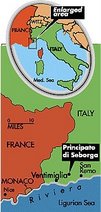With the Aida of Giuseppe Verdi, played by the Chamber Orchestra of the Principality of Seborga, the Roman Theatre of Albintimilium, the ancient name of the city of Ventimiglia, reopened to the public for the first time after almost two thousand years of closure. The event, sponsored by the Italian Ministry for the Arts and Cultural Heritage and organized by the cultural associations of Endas and Porta Marina and by the Institute of Research Angelico Aprosio, had the proper title of: “After 2000 years of silence”. 
The orchestra conducted by the maestro Vitaliano Gallo, played music from the famous Verdi Opera Aida and from the sound track movies The Gladiator and Star Wars. The proceeds of the evening went to charity.
Giampiero Martino, President of the Archaeological Park of Nervia, said: “It is with great pleasure that the city of Ventimiglia is symbolically reclaiming its history by using again this theatre that our ancestors have wanted. This is an experiment and the theatre has still serious acoustic problems to resolve caused by its proximity to the Aurelia road and the railway lines. But we are positive about resolving these problems by using sound insulation barriers”.

The orchestra conducted by the maestro Vitaliano Gallo, played music from the famous Verdi Opera Aida and from the sound track movies The Gladiator and Star Wars. The proceeds of the evening went to charity.
Giampiero Martino, President of the Archaeological Park of Nervia, said: “It is with great pleasure that the city of Ventimiglia is symbolically reclaiming its history by using again this theatre that our ancestors have wanted. This is an experiment and the theatre has still serious acoustic problems to resolve caused by its proximity to the Aurelia road and the railway lines. But we are positive about resolving these problems by using sound insulation barriers”.
The next commitment for the orchestra is for the 29 October at Imperia-Oneglia University, with a concert starting at 20:30. Music by Boccherini for the 200° anniversary of his death and for the exhibition organized by IBIS (the Italian Buddhist Institute) titled: "i semi del cambiamento" (the seeds of change).
For more information, visit: www.orchestraprincipatodiseborga.com
The construction of the theatre is dated around 180 A.C. Located on the western border of Liguria, Ventimiglia has had a complex history. It begins with the ancient Roman settlement of Albintimilium, the largest town in this part of the province. Considerable Roman remains are visible near the mouth of the Nervia River, while the mediaeval town is perched on a rocky spur to the west. The modern city did not develop until the late 19th century around the railway station. The territory of Ventimiglia offers very fine landscaping and real estate has developed in the zones of Latte and Mortola. The peerless climate and the fertility of the soil were ideal for establishing fine gardens, subsequently renovated in the late 19th century, the most remarkable being the Hanbury Garden.



